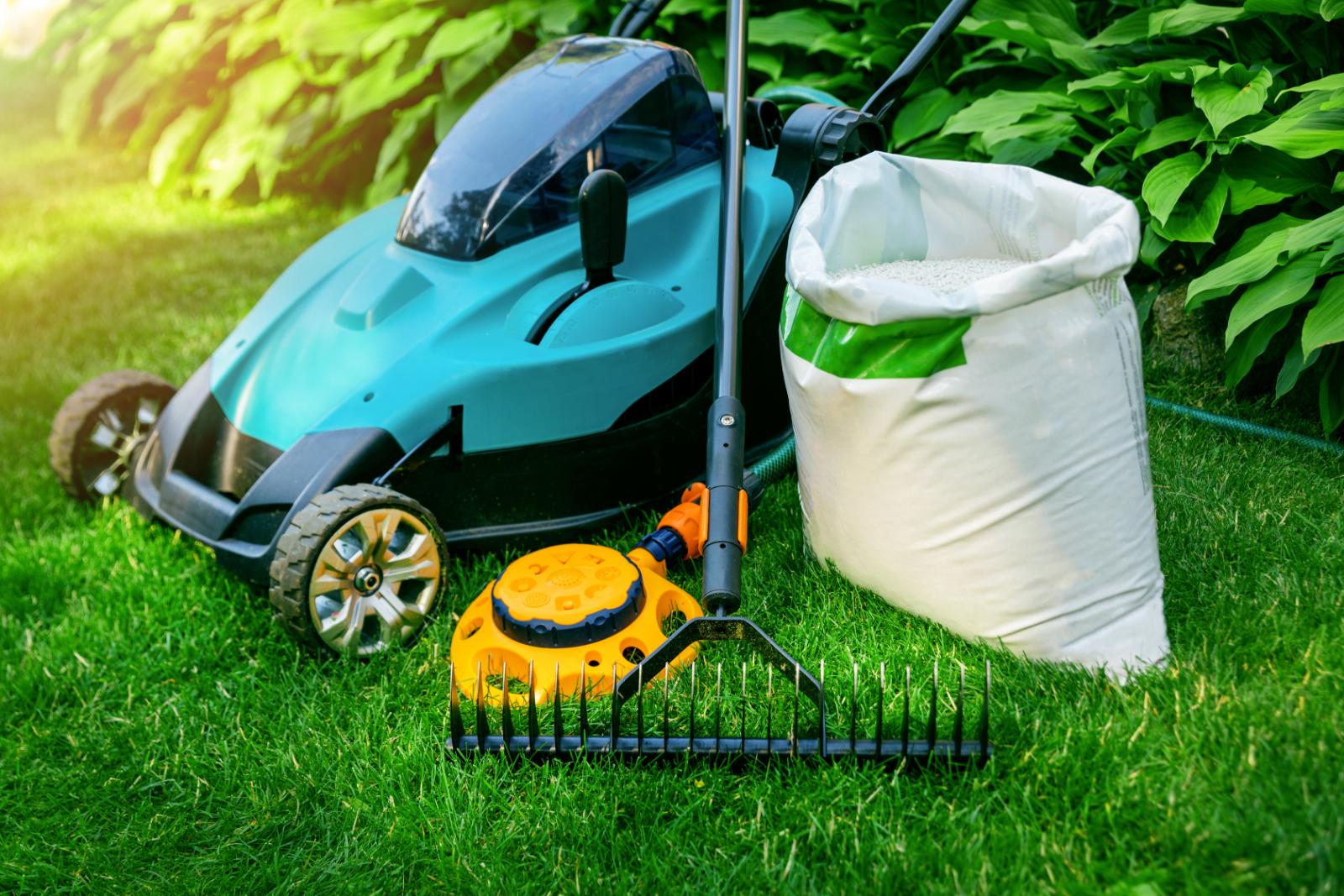Contents
As you enter spring, envision a lush, green lawn that beckons relaxation and outdoor gatherings. Imagine the satisfaction of nurturing your grass to its fullest potential, but how do you achieve this? By mastering the art of spring lawn care. From soil testing to weed control, there are essential steps you need to take to make sure your lawn thrives and becomes the envy of the neighborhood. But where should you start on this journey to lawn perfection? Let’s uncover the best tips for spring lawn care and reveal the secrets to a vibrant, healthy yard.
Key Takeaways
- Conduct a soil test to determine nutrient needs.
- Clean up debris and assess winter damage.
- Overseed for fuller grass coverage.
- Water deeply in the early morning.
- Implement organic and eco-friendly lawn care practices.
Soil Testing for Nutrient Balance
Conduct a soil test for nutrient balance this spring to ensure your lawn receives the proper nutrients it needs for healthy growth. Nutrient deficiencies and pH levels play an important role in the overall health of your lawn. By testing your soil, you can determine if any key nutrients are lacking or if the pH levels are off-balance.
Once you have identified any deficiencies or imbalances, it’s time to explore soil amendment options. You’ll come across two main categories: organic and synthetic amendments. Organic options, such as compost or manure, can improve soil structure and provide slow-release nutrients. On the other hand, synthetic fertilizers offer a quick nutrient boost but may not enhance soil health in the long term.
Early Spring Clean-Up
As you begin your early spring clean-up, start by removing winter debris, such as fallen branches and leaves, to allow your lawn to breathe and absorb sunlight.
Take a close look at your lawn for any signs of winter damage like bare patches or compacted soil, which may require special attention.
Begin planning your fertilizer application strategy to give your grass the nutrients it needs to thrive as the growing season approaches.
Remove Winter Debris
How can you efficiently tackle the task of clearing away winter debris during your early spring clean-up routine?
Start by evaluating the lawn to identify areas with the most debris accumulation. Use these raking techniques to effectively gather the debris without damaging the grass:
- Switch Direction: Alternate your raking direction to make sure you pick up all debris.
- Use the Right Tool: Choose a rake that suits your lawn size and debris type.
- Focus on Edges: Pay extra attention to lawn edges and flower beds where debris tends to gather.
- Debris Disposal: Have a designated area or compost bin for easy disposal of collected debris.
Check for Lawn Damage
Inspect your lawn meticulously for any signs of damage as part of your early spring clean-up routine. Look for areas with thinning grass, bare patches, or uneven ground. Repairing patches is vital at this stage to guarantee your lawn recovers beautifully.
Rake out dead grass, loosen the soil, and sprinkle grass seed over the damaged areas. Water gently and regularly to promote new growth. If the damage is extensive, consider sod installation for a quick fix. Sod can provide an instant lush green look to your lawn.
Remember to keep the newly repaired areas well-watered and avoid heavy foot traffic until the grass is established. Taking care of these issues early will set the stage for a healthy, vibrant lawn throughout the spring and summer.
Plan Fertilizer Application
To kickstart your early spring clean-up routine effectively, prioritize planning for the strategic application of fertilizer to nourish and revitalize your lawn. Proper timing and application of fertilizer are essential for promoting grass health and maintenance.
Here are some essential tips for planning your fertilizer application:
- Understand Your Lawn’s Needs: Consider factors like grass type, soil quality, and any specific issues your lawn may have.
- Choose the Right Fertilizer: Select a high-quality fertilizer that matches your lawn’s requirements.
- Follow Recommended Application Rates: Avoid over or under-fertilizing by carefully following the instructions on the product packaging.
- Consider Professional Help: If unsure, consult with a lawn care professional for tailored advice on fertilizer choice and application techniques.
Overseeding for Fuller Grass
Consider overseeding your lawn this spring to promote a fuller, lusher grass cover. When selecting seeds, opt for varieties that complement your existing grass type for a seamless blend. Make sure the planting depth is appropriate; typically, you’ll want to aim for around 1/4 to 1/2 inch deep. It’s important not to bury the seeds too deeply as this can hinder their growth potential.
Establish a consistent watering schedule to keep the newly seeded areas moist. Water lightly but frequently to prevent the soil from drying out, especially during the germination period, which usually ranges from 5 to 30 days, depending on the grass type. Be patient, as germination timeframes can vary.
Overseeding can help fill in bare spots, enhance the density of your lawn, and improve its overall appearance. By taking the time to overseed properly, you’ll encourage a healthier, more robust grass cover that will make your lawn the envy of the neighborhood.
Proper Watering Techniques
To guarantee your lawn thrives this spring, focus on mastering proper watering techniques.
Pay attention to watering frequency, making sure to give your lawn a deep soak rather than frequent shallow watering sessions.
Timing is essential; water your grass in the early morning to minimize evaporation and allow the grass to dry before nightfall, reducing the risk of disease.
Watering Frequency
Ensuring your lawn receives the appropriate amount of water at the correct time is essential for maintaining its health and vibrancy throughout the spring season. To achieve proper hydration and promote a thriving lawn, consider the following watering frequency tips:
- Monitor soil moisture: Check the soil regularly to determine if watering is necessary.
- Deep watering: Water deeply and less frequently to encourage deep root growth.
- Early morning watering: Opt for early morning watering to reduce evaporation and allow the grass to dry during the day.
- Avoid overwatering: Be mindful not to overwater, as it can lead to issues like root rot and fungal growth.
Time of Day
To optimize your lawn’s hydration levels, focus on watering during the best time of day for proper absorption and growth. Morning watering is ideal as it allows the grass to absorb moisture before the heat of the day evaporates it. Watering in the morning also helps prevent the growth of fungus and diseases that can occur when the grass stays wet overnight.
It’s recommended to water in the early morning, preferably before 10 a.m., to give your lawn enough time to dry before evening. Additionally, consider evening fertilizing. Fertilizing in the evening allows the nutrients to soak into the soil overnight, promoting strong root development.
Weed Control Strategies
For effective weed control in your lawn this spring, consider implementing a multi-faceted approach targeting different types of weeds. To achieve a lush, weed-free lawn, follow these practical strategies:
Weed Prevention: Start by preventing weed growth through proper lawn care practices like regular watering, fertilizing, and overseeding to promote a thick turf that naturally inhibits weed growth.
Herbicide Application: Use selective herbicides to target specific weed varieties without harming your grass. Apply herbicides early in the season when weeds are actively growing for better control.
Integrated Pest Management: Employ integrated pest management techniques such as manual weed removal, biological controls like beneficial insects, and cultural practices to minimize weed populations.
Mulching Techniques: Mulch your garden beds to suppress weed growth by blocking sunlight and preventing weed seeds from germinating. Use organic mulches like bark chips or straw for both weed control and soil improvement.
Mowing Height Adjustment
Maintain an appropriate mowing height to promote a healthy and resilient lawn during the spring season. Adjusting the height at which you mow your lawn can have a substantial impact on its health and appearance. Different grass types thrive at specific heights, so it’s essential to take into account your grass type and sun exposure when setting your mower blades. Here’s a helpful table to guide you in adjusting your mowing height effectively:
| Grass Type | Mowing Height | Sun Exposure |
|---|---|---|
| Bermuda Grass | 1-1.5 inches | Full sun |
| Kentucky Bluegrass | 2-2.5 inches | Full sun to partial shade |
| Zoysia Grass | 1-2 inches | Full sun |
| Fescue Grass | 2-3 inches | Shade tolerant |
| St. Augustine Grass | 2-3 inches | Full sun to partial shade |
Implementing Organic Fertilizers
Adapting your lawn care routine to include organic fertilizers can greatly improve the health and vigor of your grass as the spring season progresses. Organic soil amendments are a fantastic way to enrich the soil, providing essential nutrients to your lawn in a natural and sustainable manner.
Here are some practical tips for implementing organic fertilizers effectively:
- Choose the Right Type: Opt for organic fertilizers such as compost, manure, or organic lawn food to feed your grass without the use of harsh chemicals.
- Apply at the Right Time: Timing is essential when it comes to fertilizing. Apply organic fertilizers in early spring to support healthy growth throughout the season.
- Follow Application Guidelines: Be sure to follow the instructions on the product packaging to avoid over-fertilizing, which can harm your lawn.
- Enjoy Mulching Benefits: Mulching with organic materials like grass clippings or shredded leaves can help retain moisture, suppress weeds, and provide additional nutrients to the soil.
Importance of Lawn Aeration
To ensure the best health and growth of your grass this spring, consider the important practice of lawn aeration. Aeration benefits your lawn by allowing air, water, and nutrients to penetrate the soil more effectively, reaching the grass’s roots. This process helps to alleviate soil compaction, which can hinder root growth and overall grass health. By aerating your lawn, you create an ideal environment for a lush, thriving lawn.
There are a few aeration techniques you can consider for your lawn. One common method is core aeration, where small plugs of soil are removed from the ground, allowing for better air circulation. Another technique is spike aeration, which involves poking small holes into the soil to achieve similar results. Both methods can greatly improve the health of your lawn, promoting stronger roots and better nutrient absorption.
Make sure to aerate your lawn at least once a year, preferably in the spring or fall, to enjoy the full benefits of this essential lawn care practice.
Eco-Friendly Pest Management
Consider implementing eco-friendly pest management techniques to protect your lawn from harmful insects and pests while maintaining a healthy environment for your grass to thrive. Here are some practical tips to help you achieve this:
Natural Predators: Encourage the presence of beneficial insects like ladybugs, lacewings, and predatory beetles in your lawn. These natural predators feed on common lawn pests, helping to control their populations without the need for harmful chemicals.
DIY Remedies: Create homemade pest control solutions using ingredients like neem oil, garlic spray, or soap spray. These DIY remedies are effective at deterring pests while being safe for your lawn, family, and the environment.
Companion Planting: Plant pest-repelling herbs and flowers such as marigolds, lavender, and basil around your lawn to naturally deter insects. Companion planting can help create a balanced ecosystem that minimizes pest infestations.
Healthy Soil: Maintain a well-balanced soil ecosystem by regularly aerating, composting, and avoiding over-fertilization. Healthy soil promotes strong grass growth, making it more resistant to pest damage.
Review
Now that you’ve armed yourself with these best tips for spring lawn care, your lawn is poised to flourish like a well-tended garden.
Just as a gardener nurtures their plants to bloom, you too can cultivate a lush, vibrant lawn that will be the envy of the neighborhood.
Remember, with the right care and attention, your lawn will grow into a beautiful oasis for you to enjoy all season long.
Happy gardening!




